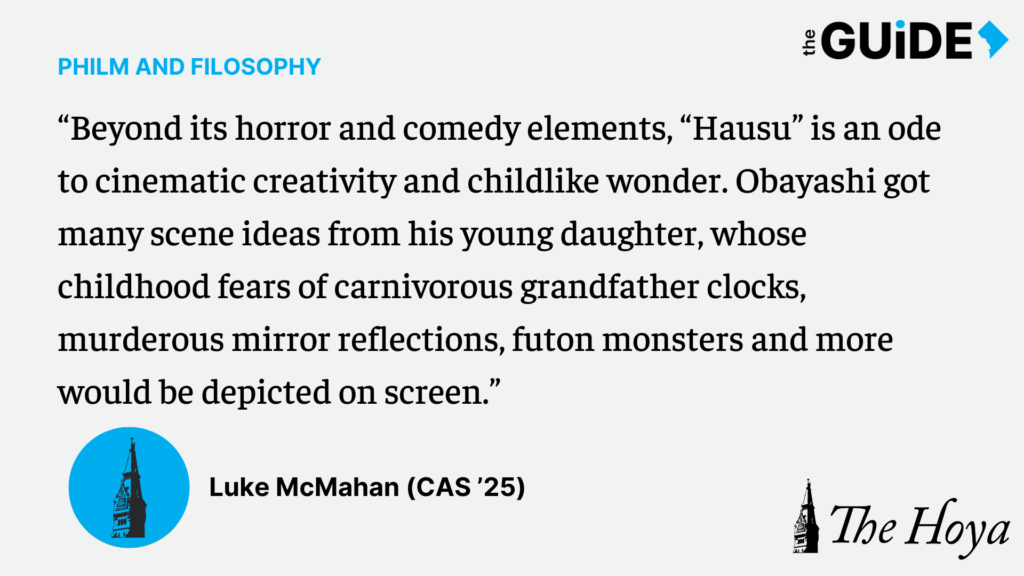Cinema was losing steam in 1970s Japan. Television reigned culturally supreme, and the few film studios that were sponsoring projects — albeit with less capital than in previous decades — mainly focused on earnest and serious subject matter with a more traditional style, calling on homegrown, veteran directors to do so.
But when Toho Studios asked a man who made commercials to remake “Jaws,” what followed was one of the most eclectic and playful horror films of all time, which was part of a rebirth in Japanese cinema and influenced a generation of filmmakers and critics. Inspired by the ingenuity of French New Wave cinema and with plenty of advice from his elementary-school-age daughter, director Nobuhiko Obayashi created the truly singular film “Hausu.”
I will not spend much time discussing the full history behind the creation of “Hausu,” though it could merit an entire article on its own. I will instead focus on how unique and special this film is, not just for its time and context, but for cinema as a whole.
Beyond its horror and comedy elements, “Hausu” is an ode to cinematic creativity and childlike wonder. Obayashi got many scene ideas from his young daughter, whose childhood fears of carnivorous grandfather clocks, murderous mirror reflections, futon monsters and more would be depicted on screen.
The film’s seven main characters were untested commercial actresses whom Obayashi met on previous jobs. In fact, the director gave up on giving verbal acting notes to the amateurs and instead let the film’s soundtrack, a blend of classical and soft rock, guide their performances. The rest of the cast was rounded out by the director’s family, friends and the sole veteran actress, Yoko Minamida, who played the main villain.
Obayashi and his crew opted not to pursue realistic effects, instead they experimented each day with practical and inventive solutions to capture their dreamlike ideas on screen. As most of the crew’s filmmaking experience was in advertisements and television, the techniques used in “Hausu” were either entirely new or drawn from different visual media.
The groundbreaking kinetic editing techniques made famous by French New Wave directors, in direct contrast to French cinema at the time, inspired the director. In a similar rule-breaking spirit, Obayashi would ask himself, “If Kurosawa or Ozu [two respected Japanese directors] were to see it, what direction would offend them most?”
“Hausu,” with its ideas taken from the nightmares and fears of a child, almost entirely untested and new actors, experimental effects never before used in film and intent to deviate from traditional Japanese cinema, was entirely distinct in composition and form.
But “Hausu” is not just 88 minutes of raw cinematic play. Its often elusive yet substantial emotional undercurrent transforms the childlike nightmare of a house that eats young girls into a masterpiece of atomic absurdism.
Obayashi was born just outside of Hiroshima and was seven years old when the atomic bombs were dropped.
“All of my close childhood friends died because of the bomb, so I wanted to write a fantasy with the atomic bomb as a theme,” Obayashi said.
The old woman who is the sole inhabitant of the titular house and hosts the seven young girls for summer vacation was betrothed to a Japanese soldier, who would die in World War II. The woman’s bitterness and survivor’s guilt about being left behind after the war becomes an evil spirit which possesses the house, causing it to eat other young, unmarried women.
Although the backstory is just a small part of the film’s script, the emotional and historical weight it provides the rest of the film is invaluable. One may see the film’s narrative as Obayashi’s way of grappling with the fear and trauma he experienced at the loss of his friends and destruction of his home. In depicting horrible events and the destructive grief of older characters with a childlike eye, “Hausu” both represents a generation’s atomic terror and their lifetime coping with it.
“Hausu” is a monument to the wondrous and dreamlike capabilities of cinema. Its striking visuals, experimental effects and often outlandish amateur performances lend the film a playful, dreamlike air. Obayashi uses some of these elements to communicate survivor’s guilt and trauma over World War II and the atomic bomb. This makes “Hausu” an utterly unique cinematic portrayal with a combination of the childishly nightmarish and absurdly terrifying.














